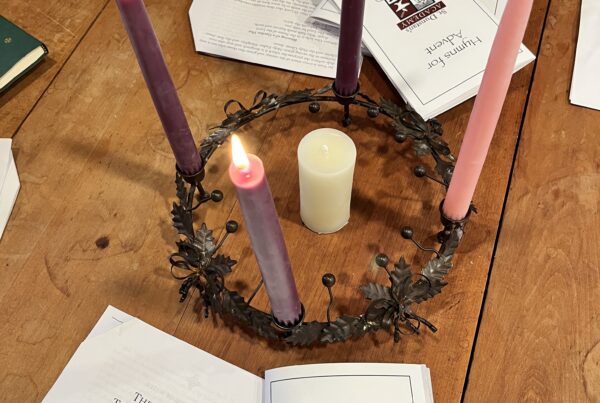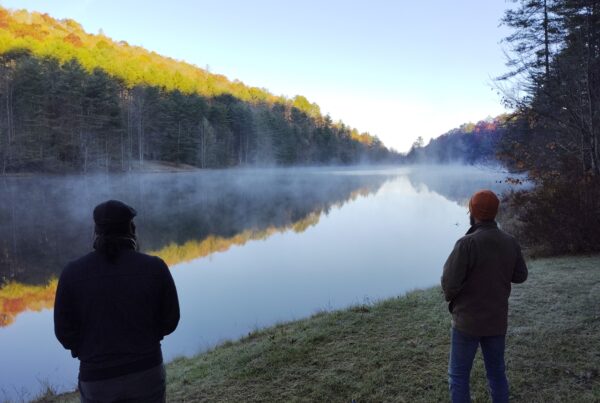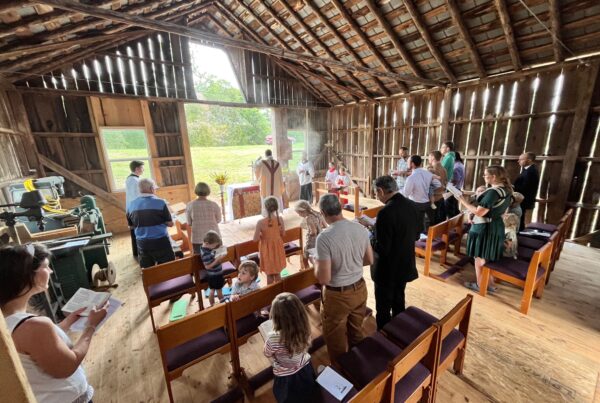This essay by Natalie Fickley, wife of our Founder and Headmaster, was originally published in the February edition of Harp & Hammer, St. Dunstan’s bimonthly newsletter. Subscribe here!

Four months ago, our family moved from a small city with our seven children, six of them boys, to a century-old farmhouse on the campus of St. Dunstan’s Academy. We moved to campus to better facilitate the school’s development and prepare the farmhouse for use as our first faculty building, but the move was also an answer to prayer for our family. We knew (as our neighbors did, I’m sure) that as our many boys grow older they will need more space to adventure out, expending their energy in inspiring and productive ways, in the safe context of a trusted community. The move has naturally changed our family’s life a good bit. Reflecting on the past four months, we have been able to better live out our educational philosophy, which has moved from the realm of ideals into reality simply because of where we are.
Not much has shifted in terms of the literature we read to the boys, the math lessons they complete, or the homeschool checklist they must accomplish each day. What has changed, however, are many of the things which set St. Dunstan’s apart from most classical Christian schools.
Charlotte Mason says education is an atmosphere, and although the old farm’s environment has plenty of room for improvement — multiple old outbuildings need repair or removal, invasive plants crowd different sections of campus, and there are many half-finished projects — I can feel the difference in the air. The old vernacular farmhouse’s simple but beautiful architectural details — details that were absent from our 1950s ranch house — lift up my spirit in a way I didn’t expect. The beauty of the outdoors, and the quiet at night especially, allows us to “delight ourselves in an abundance of peace” (Ps. 37:11). One of our guiding principles when it comes to constructing our campus is borrowed from Winston Churchill: “we shape our buildings, thereafter they shape us.” Our aim is to shape inspiring buildings for when SDA students are indoors, and allow the boys plenty of time outdoors to relish in the readily available beauty God has given us in the campus’s woods, fields, and mountain views.
Before we moved, we went on many hikes, camping trips, excursions, and other “adventures” (of which there are many in a big family, if you use Chesterton’s definition: “an inconvenience rightly considered”). But here, our adventures have been real rather than simulated, and the boys have been thriving on them: heating the house exclusively with wood, especially when we didn’t have time to season our fuel before moving, sledding groceries down a quarter-mile frozen gravel driveway in the moonlight so we could eat something other than pea-soup, learning how to burn brush safely to keep campus clear. In all of these activities our boys have enjoyed participating in the work of living, which they truly are an asset to.
The rural setting of campus provides plenty of opportunities for our students to have real adventures, whether backpacking over the nearby Priest Mountain, visible just to the west of campus, hiking between classes in the nearby woods, orienteering, building, exploring, or camping.
The biggest change for me has been living without the internet due to the remoteness of our location. Focusing on my vocation as wife and mother has been much easier without the myriad distractions available on the internet. With The Joy of Cooking, The Handbook of Nature Study, a good dictionary, Bible concordance, and weather alert radio on the shelf, along with my occasional phone call to Mom, I haven’t missed constant connectivity one bit. It has been freeing. As a family we enjoy our time together not as easily distracted or pulled away by outside pressures.
Next to the house is an old spring box and spring house. We had been told the spring dried up a decade ago. It turns out the spring was just blocked by years of dirt settling, and once that was removed, the water started flowing freely. While I shoveled out the muck and watched the water start to flow, a clear parallel came to mind. The Lord is ready to speak to us, but sometimes we just have to remove distractions to let the wellspring of life flow and water our hearts.
At St. Dunstan’s, our students will live under a temporary rule of what we’re calling “digital poverty,” not because we think they should eschew computers and live like 19th-century farmers for the rest of their lives, but in order to remove distractions, focus on their vocation as students, be prepared and able to hear the “still small voice,” remain attentive to the people in front of them, and have the time for many worthwhile pursuits they might forgo for the easy distractions of the web-based world.
Thank you to everyone who has helped us begin to build this school, and make this kind of life possible for many boys in the years to come. Vitam abundantius habere!





